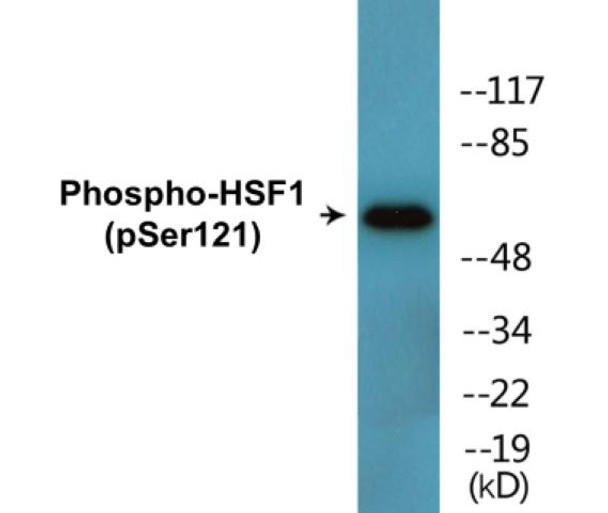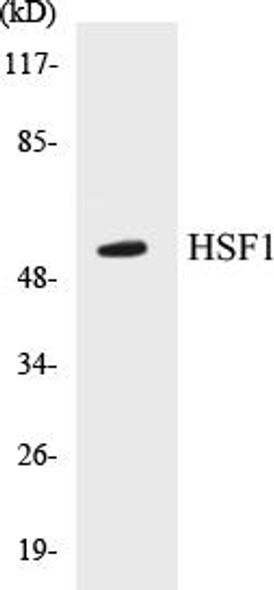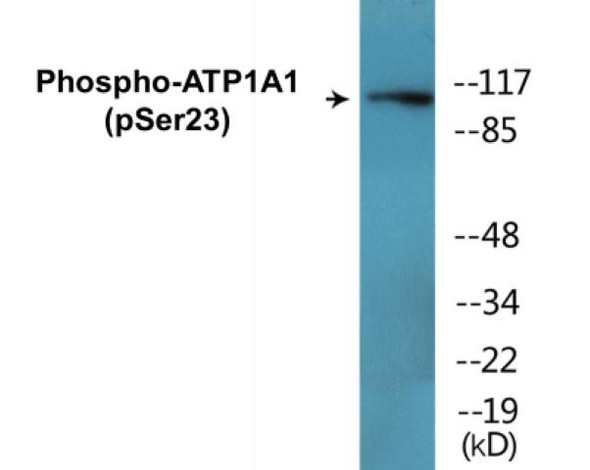HSF1 (Phospho-Ser121) Colorimetric Cell-Based ELISA Kit
- SKU:
- CBCAB01631
- Product Type:
- ELISA Kit
- ELISA Type:
- Cell Based Phospho Specific
- Research Area:
- Epigenetics and Nuclear Signaling
- Reactivity:
- Human
- Mouse
- Detection Method:
- Colorimetric
Description
HSF1 (Phospho-Ser121)Colorimetric Cell-Based ELISA Kit
The HSF1 Phospho-Ser121 Colorimetric Cell-Based ELISA Kit is a cutting-edge tool designed for the precise measurement of HSF1 phosphorylation at Ser121 in cell samples. This kit boasts exceptional sensitivity and specificity, ensuring accurate and reproducible results for researchers in the field.HSF1 (Heat Shock Factor 1) is a key transcription factor involved in the cellular response to stress, regulating the expression of heat shock proteins to protect cells from damage. Phosphorylation of HSF1 at Ser121 is critical for its activation and function, playing a pivotal role in various cellular processes.
With its ability to detect and quantify phosphorylated HSF1 in cell samples, this ELISA kit is indispensable for studying the mechanisms underlying stress response, cell survival, and disease progression. Researchers can rely on this kit to advance their research in fields such as cancer biology, neurodegenerative disorders, and cellular stress pathways.
| Product Name: | HSF1 (Phospho-Ser121) Colorimetric Cell-Based ELISA |
| Product Code: | CBCAB01631 |
| ELISA Type: | Cell-Based |
| Target: | HSF1 (Phospho-Ser121) |
| Reactivity: | Human, Mouse |
| Dynamic Range: | > 5000 Cells |
| Detection Method: | Colorimetric 450 nm |
| Format: | 2 x 96-Well Microplates |
The HSF1 (Phospho-Ser121) Colorimetric Cell-Based ELISA Kit is a convenient, lysate-free, high throughput and sensitive assay kit that can detect HSF1 protein phosphorylation and expression profile in cells. The kit can be used for measuring the relative amounts of phosphorylated HSF1 in cultured cells as well as screening for the effects that various treatments, inhibitors (ie. siRNA or chemicals), or activators have on HSF1 phosphorylation.
Qualitative determination of HSF1 (Phospho-Ser121) concentration is achieved by an indirect ELISA format. In essence, HSF1 (Phospho-Ser121) is captured by HSF1 (Phospho-Ser121)-specific primary (1ø) antibodies while the HRP-conjugated secondary (2ø) antibodies bind the Fc region of the 1ø antibody. Through this binding, the HRP enzyme conjugated to the 2ø antibody can catalyze a colorimetric reaction upon substrate addition. Due to the qualitative nature of the Cell-Based ELISA, multiple normalization methods are needed:
| 1. | A monoclonal antibody specific for human GAPDH is included to serve as an internal positive control in normalizing the target absorbance values. |
| 2. | Following the colorimetric measurement of HRP activity via substrate addition, the Crystal Violet whole-cell staining method may be used to determine cell density. After staining, the results can be analysed by normalizing the absorbance values to cell amounts, by which the plating difference can be adjusted. |
| Database Information: | Gene ID: 3297, UniProt ID: Q00613, OMIM: 140580, Unigene: Hs.530227/Hs.571397 |
| Gene Symbol: | HSF1 |
| Sub Type: | Phospho |
| UniProt Protein Function: | HSF1: a transcription factor that specifically binds heat shock promoter elements (HSE) and activates transcription. Induced in response to heat, heavy metals, and oxidative stress. In higher eukaryotes, HSF is unable to bind to HSEs unless the cells are stressed. Becomes phosphorylated in response to stress, forming homotrimers that bind DNA and activate transcription. Phosphorylation by PLK1 enhances nuclear translocation, and phosphorylation by CaMKII enhances transactivation. Phosphorylation by GSK3 and ERK1 induces binding by 14-3-3 and sequestration in the cytoplasm. In addition, during attenuation from the heat shock response, HSF1 is repressed by direct binding of Hsp70, HSP40, and HSF binding protein 1 (HSBP1). Four alternatively spliced isoforms have been described. |
| UniProt Protein Details: | Protein type:Transcription factor; DNA-binding Chromosomal Location of Human Ortholog: 8q24.3 Cellular Component: nucleoplasm; protein complex; pronucleus; cytoplasm; cytosol Molecular Function:protein binding; chromatin binding; transcription factor activity Biological Process: negative regulation of cell proliferation; embryonic placenta development; embryonic process involved in female pregnancy; mRNA transcription; female meiosis; positive regulation of transcription from RNA polymerase II promoter; response to lipopolysaccharide; defense response; spermatogenesis; negative regulation of tumor necrosis factor production; negative regulation of transcription from RNA polymerase II promoter; positive regulation of multicellular organism growth; protein amino acid phosphorylation |
| NCBI Summary: | The product of this gene is a heat-shock transcription factor. Transcription of heat-shock genes is rapidly induced after temperature stress. Hsp90, by itself and/or associated with multichaperone complexes, is a major repressor of this gene. [provided by RefSeq, Jul 2008] |
| UniProt Code: | Q00613 |
| NCBI GenInfo Identifier: | 462333 |
| NCBI Gene ID: | 3297 |
| NCBI Accession: | Q00613.1 |
| UniProt Secondary Accession: | Q00613,Q53XT4, A8K4L0, A8MW26, |
| UniProt Related Accession: | Q00613 |
| Molecular Weight: | 529 |
| NCBI Full Name: | Heat shock factor protein 1 |
| NCBI Synonym Full Names: | heat shock transcription factor 1 |
| NCBI Official Symbol: | HSF1 |
| NCBI Official Synonym Symbols: | HSTF1 |
| NCBI Protein Information: | heat shock factor protein 1; HSF 1; HSTF 1 |
| UniProt Protein Name: | Heat shock factor protein 1 |
| UniProt Synonym Protein Names: | Heat shock transcription factor 1; HSTF 1 |
| Protein Family: | Heat shock factor protein |
| UniProt Gene Name: | HSF1 |
| UniProt Entry Name: | HSF1_HUMAN |
| Component | Quantity |
| 96-Well Cell Culture Clear-Bottom Microplate | 2 plates |
| 10X TBS | 24 mL |
| Quenching Buffer | 24 mL |
| Blocking Buffer | 50 mL |
| 15X Wash Buffer | 50 mL |
| Primary Antibody Diluent | 12 mL |
| 100x Anti-Phospho Target Antibody | 60 µL |
| 100x Anti-Target Antibody | 60 µL |
| Anti-GAPDH Antibody | 60 µL |
| HRP-Conjugated Anti-Rabbit IgG Antibody | 12 mL |
| HRP-Conjugated Anti-Mouse IgG Antibody | 12 mL |
| SDS Solution | 12 mL |
| Stop Solution | 24 mL |
| Ready-to-Use Substrate | 12 mL |
| Crystal Violet Solution | 12 mL |
| Adhesive Plate Seals | 2 seals |
The following materials and/or equipment are NOT provided in this kit but are necessary to successfully conduct the experiment:
- Microplate reader able to measure absorbance at 450 nm and/or 595 nm for Crystal Violet Cell Staining (Optional)
- Micropipettes with capability of measuring volumes ranging from 1 µL to 1 ml
- 37% formaldehyde (Sigma Cat# F-8775) or formaldehyde from other sources
- Squirt bottle, manifold dispenser, multichannel pipette reservoir or automated microplate washer
- Graph paper or computer software capable of generating or displaying logarithmic functions
- Absorbent papers or vacuum aspirator
- Test tubes or microfuge tubes capable of storing ≥1 ml
- Poly-L-Lysine (Sigma Cat# P4832 for suspension cells)
- Orbital shaker (optional)
- Deionized or sterile water
*Note: Protocols are specific to each batch/lot. For the correct instructions please follow the protocol included in your kit.
| Step | Procedure |
| 1. | Seed 200 µL of 20,000 adherent cells in culture medium in each well of a 96-well plate. The plates included in the kit are sterile and treated for cell culture. For suspension cells and loosely attached cells, coat the plates with 100 µL of 10 µg/ml Poly-L-Lysine (not included) to each well of a 96-well plate for 30 minutes at 37 °C prior to adding cells. |
| 2. | Incubate the cells for overnight at 37 °C, 5% CO2. |
| 3. | Treat the cells as desired. |
| 4. | Remove the cell culture medium and rinse with 200 µL of 1x TBS, twice. |
| 5. | Fix the cells by incubating with 100 µL of Fixing Solution for 20 minutes at room temperature. The 4% formaldehyde is used for adherent cells and 8% formaldehyde is used for suspension cells and loosely attached cells. |
| 6. | Remove the Fixing Solution and wash the plate 3 times with 200 µL 1x Wash Buffer for five minutes each time with gentle shaking on the orbital shaker. The plate can be stored at 4 °C for a week. |
| 7. | Add 100 µL of Quenching Buffer and incubate for 20 minutes at room temperature. |
| 8. | Wash the plate 3 times with 1x Wash Buffer for 5 minutes each time. |
| 9. | Add 200 µL of Blocking Buffer and incubate for 1 hour at room temperature. |
| 10. | Wash 3 times with 200 µL of 1x Wash Buffer for 5 minutes each time. |
| 11. | Add 50 µL of 1x primary antibodies Anti-HSF1 (Phospho-Ser121) Antibody, Anti-HSF1 Antibody and/or Anti-GAPDH Antibody) to the corresponding wells, cover with Parafilm and incubate for 16 hours (overnight) at 4 °C. If the target expression is known to be high, incubate for 2 hours at room temperature. |
| 12. | Wash 3 times with 200 µL of 1x Wash Buffer for 5 minutes each time. |
| 13. | Add 50 µL of 1x secondary antibodies (HRP-Conjugated AntiRabbit IgG Antibody or HRP-Conjugated Anti-Mouse IgG Antibody) to corresponding wells and incubate for 1.5 hours at room temperature. |
| 14. | Wash 3 times with 200 µL of 1x Wash Buffer for 5 minutes each time. |
| 15. | Add 50 µL of Ready-to-Use Substrate to each well and incubate for 30 minutes at room temperature in the dark. |
| 16. | Add 50 µL of Stop Solution to each well and read OD at 450 nm immediately using the microplate reader. |
(Additional Crystal Violet staining may be performed if desired – details of this may be found in the kit technical manual.)










